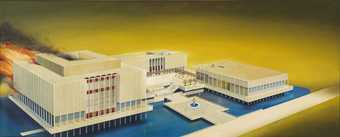I first saw Millais’s Ophelia 1851–2 when I came to the UK in 1961, and was struck by its originality. It’s hard to explain what I first saw in it, but it was a moving picture to me and so realistically painted. I guess I had a fondness for all sorts of Pre-Raphaelite images back then, a feeling which subsequently passed, but the nature of this painting stayed with me. It holds true today as one of the most profound paintings of that period.
At first I didn’t delve too much into the story and the symbolism behind it. I viewed it strictly as a picture – how it was composed and so on – but later I learned that it had been studied and analysed by so many people, which made it even more interesting. Every little blade of grass and plant has been botanically identified. Someone has discovered almost exactly where Millais set up his easel by the river. Some believe there is a skull hidden in the painting (just to the left of the forget-me-nots on the righthand side). The painting itself is like an embellishment of the Ophelia story in Shakespeare’s Hamlet. The fact that she was portrayed as a mad woman during Millais’s time was, I guess, considered unsuitable subject matter. You did not paint mad people. However, when I look at the woman in the water there, I don’t see a mad woman. I see a tragic woman.
I would never realise that this painting would affect me the way it did. Ophelia became a trigger in my art; an inspiration for what I’m doing. You notice here you are looking at the woman from an oblique angle – in a sense, it’s an aerial view. The diagonal of Ophelia in the water is an aspect that was made for my work. My study of art and much that came out of it is ordered on that thinking that you look at something almost as if it were a table-top arrangement, as you can find in Ophelia. I regard a lot of my paintings and even photographs (such as Thirtyfour Parking Lots 1967) as off-springs of this painting. For example, Los Angeles County Museum of Art on Fire, painted from 1965 to 1968, has a similar angle to that of Ophelia – looking down on it from above. Also, the tragic circumstances of a situation in my painting are told, I think, in a very bucolic and pastoral way, just as they are in Millais’s picture.

Ed Ruscha
Los Angeles County Museum of Art on Fire 1968
Oil on canvas
135.9 x 339.1 cm
Photo: Lee Stalsworth
Courtesy Hirshhorn Museum and Sculpture Garden, Washington DC © Ed Ruscha.
The composition of Ophelia is very simple, and yet so complex for what it is saying. And it evolves right into my thinking. When I make a picture that might resemble it, I’m not doing it on purpose. It’s just happened from years ago seeing Millais’s image. I don’t get this response from any other of his paintings that I’ve seen, but with this one he hit the nail on the head.
Of course, my pictures and Ophelia are very different in intent and content. They are worlds apart in so many ways: Ophelia is in the grand tradition of English painting, and the story goes back to Shakespeare, whereas Los Angeles County Museum of Art on Fire goes back to 1968 and, you could say, is the culmination of commercial America. But pictorially they are connected. They are like brother and sister. I feel as if there is a little silver thread between that painting and mine. So maybe the years between the works are not that distant.
In some ways I think that I am looking at myself when I am looking at Ophelia. So each time I come to London I feel an obligation to see it, but it is an obligation I feel good about.
